

Skylar Deckhoff-Jones - NanoJapan 2014
Tulane University
Major: Physics
Class Standing: Sophomore
Anticipated Graduation: May 2016
NanoJapan Research Lab:Femotosecond Spectroscopy Group, Prof. Keshav Dani, Okinawa Institute of Science & Technology
NanoJapan Research Project: ![]()
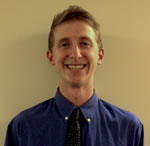
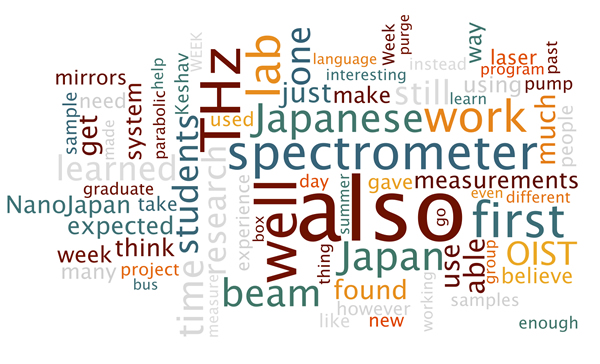
Why NanoJapan?
Many incoming undergraduate students have a very abstract idea of what research is. They picture lab coats, fume hoods, and particle accelerators, but without the hands-on experience it is impossible to really get a clear picture. NanoJapan offers a first-person view of what it really means to work with brilliant minds on the cutting edge of terahertz nanoscience. But it also goes one step further, and gives students the chance to see outside the boundaries of the United States and get a holistic view of scientific research on an international level.
I have always wanted the opportunity to study abroad to gain an international perspective of my education. However, I quickly found after talking to my advisor that it is uncommon and very difficult for a physics major to spend a semester studying abroad. NanoJapan offers me that opportunity to experience a foreign culture while also pursuing my love of physics. Additionally, I have been considering the possibility of attending graduate school abroad and NanoJapan will confirm if this is something I want to do. By doing research in Japan on nanotechnology, I will not only be exposing myself to a promising new field, but also gaining a new cultural perspective of scientific research. I am beyond excited for the unique cultural and intellectual challenges I will face, and the new perspectives I will gain this coming summer.
My goals for this summer are to:

A panorama that gives a sense of just how stunningly huge Tokyo is.
So far my experiences in Japan have exceeded my expectations in every way. Tokyo is bigger than I had expected. The buildings are taller and more abundant than I expected. Tokyo is more crowded than I expected. The street signs are brighter and more enticing than I expected. The subway and train system are more encompassing convenient than I expected. It rains more and longer than I expected. The bento boxes are larger and more delicious than I expected. I enjoyed cow stomach soup more than I expected. The meals are more reasonably priced than I expected. My days are definitely busier than I expected. I have learned more Japanese than I expected. I have had to drink more coffee than I expected. I have learned more from the science lectures than I expected. The people are friendlier than I expected. I have formed closer relationships with the KIP students than I expected. The NanoJapan students have become a family faster than I expected. The NanoJapan students already mean more to me than I expected. I am having more fun than I had ever expected. The only thing that has not exceeded my expectations is the size of the dogs.
The Japanese classes have been a challenge, but the sense of accomplishment is worth it. I underestimated the speed and amount that we were going to be learning each day. It is very challenging to remain focused for that long of a period, but Lauren, Ramya, Ben and I always walk out of class in aww of the amount we had learned. Luckily the AJALT sensei's lessons are very interactive and force me to stay attentive. Unfortunately I have also found it difficult to give the work the amount of review it truly needs. I find it very difficult to cement all of what was learned is my mind. I have found that whenever I am walking around, it is helpful to review the vocabulary learned the day before. I believe I do my best thinking while walking/pacing, so this has helped. I have also found it helpful to try and think of particular situations that I can use what I have learned. There are also no shortage of signs to practice my hiragana and katakana reading skills on while exploring. I have definitely noticed some cultural differences already while in Japan. Funnily The first thing that I noticed the first night was that J-walking is nearly never done in Tokyo. In the U.S. if the road is empty, most will simply quickly walk across if it is not too wide. However, I noticed that even if it is a thin one lane road, nearly always people will still wait for the walk sign. I have also been amazed by the attention paid to detail. Everything has its place and everything is so clean. I noticed the other day a custodial staff of the language class building polishing the floor harder and closer than any American custodial staff member would. I was also impressed with the detail and work that KIP student Mami-san put into making a Kamakura map for us students. It was a sweet gesture that very likely would not occur in the U.S. One thing that I am curious about is how all retail workers are so happy and friendly. It seems that they never get bogged down with the work they are doing. How is everyone here so content with their work? Ultimately my first week has been rewarding, exciting, and eye-opening and I can't wait for everything else I will experience.
Research Project Overview at the Femotosecond Spectroscopy Group, Prof. Keshav Dani, Okinawa Institute of Science & Technology
This summer, I will have the exciting opportunity to construct an optical pump terahertz probe spectrometer. Optical pump THz probe, or time-resolved THz spectroscopy, employs a short visible or infrared excitation pulse. Because of the comparably low energy of the probing THz pulse, the relaxation of charge carriers is able to be measured. Time-resolved THz spectroscopy is most commonly used to study semiconductors, as the pump pulse can be used to excite electrons into the conduction band, while the probe can measure the state of the electrons a very short time after the excitation. Time-resolved THz spectroscopy has also been used to make measurements on superconductors. Semiconductors are considered 3-D because the x, y, and z dimensions of the sample will always be much greater than the Thermal de Broglie wavelength of the electrons. Semiconductors offer themselves to a wide range of applications from transistors to solar cells. THz measurements of semiconductors can be used to determine the transient conductivity as well as the complex dielectric function. (Time-resolved Terahertz Spectroscopy. Lund University, Web. 25 May 2014.)
The subway and train system of Japan almost acts as its own foreign subculture within the larger Japanese culture. There are clear actions, patterns, and rules that foreigners must take upon themselves to learn and practice. My first time in the metro system I felt completely lost. There are a multitude of cards and tickets, gates that close on you, and large crowds moving systematically to get to where they want to go. I had no idea how to read the maps, or even what to do once I was on the subway. I did however realize that there was a strict sense of order to the seeming madness.
After getting my Pasmo card I felt much more comfortable because it greatly simplified the payment process. Initially I was confused as to what prevented people from walking through the gates without paying, but soon saw the motion sensitive padded barriers that popped out in such a case. Once reaching the actual subway, I assumed it would be pretty simple process of just walking onto the car. However when the subway finally arrived the door opened to a wall of more bodies. The first thing that I quickly learned is that there is always more room for people. You just keep pushing forward and where there seemed to be a shortage of space, you just sort of sink into place. Although it hasn't happened to me yet, I hear there are also cases where station workers literally push people into the carts to make it fit. However, the majority of the time there is ample space to stand; however the prized seats have their own rules as well. There are signs throughout the car suggesting to give seats to injured, elderly, pregnant, and children, and from what I have seen this is strictly followed. The seats are generally always filled if available, but occasional if ones stop is approaching they will remain standing.
One thing that bewildered me was how the sleeping commuters would not miss their stops. Initially I assumed there was an app or alarms, but after speaking with a KIP (Japanese) student I discovered that the daily routine of the commuters is so familiar that they learn to train their body to sleep for the correct length of time. Although many choose to sleep during their time on the subway, many more also choose to read a book or manga. Some find it a good time to study or even just think. One thing that is never done is eating on the subway or train. In fact, eating is not done while walking in public either. Unlike in the U.S. there is absolutely no talking among commuters. Nearly everyone enjoyed his or her ride in silence. Additionally, in the U.S. the carts are not nearly as crowded.
In general I have experienced that Japan is a much more polite country than the U.S. Most interactions I am met with smiles and “thank you”s. This is in contrast with the U.S. where many interactions are simply to get what is needed and there is not any human connection or pleasantries. In some senses it is nice, but in my American mind I see it, as being easier to just be blunt and not put so much effort into being polite. Ultimately I believe that the pleasantries are ultimately a result of how much Japanese care about presentation. Everyone dresses well and is polite in day-to-day interactions. However I want to believe that it goes deeper than presentation, and that the Japanese people truly are that courteous, caring, and organized.
Japan has a series of values that are shared culturally, and these values can be easily seen in the public transportation system as well. The Japanese are known for their shared care for the well being of those around them. There is also a stress on order and having everything be neat and clean. The first can easily be seen by the way that there is a hierarchy for who gets seated on the trains and subway. The later can be seen by how food is never eaten on the subway, presumably to keep it clean. Order can also be seen in the subway system, as once the patterns are learned, it is probably one of the most efficient and convenient systems I have experienced.
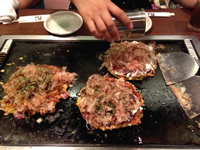
Okonomiyaki: A delicious Japanese food that lets you Waterfall: A beautiful waterfall that was a cook the mixture of ingredients yourself on a griddle.
Intro to Nanoscience Lectures
Bird-Sensei's two lectures gave an overview of general semiconductor theory, engineering of heterostructures, and graphene as a zero-bandgap semiconductor. I found them to be a great introduction to topics I now very little about. Bird-Sensei's second lecture focused on the structure, uses, and limitation of graphene as a semiconductor.
Maruyama-sensei gave a thorough overview of the work his lab has conducted on graphene and nanotubes. I found it particularly amazing that they are capable of producing such large single pieces of graphene. I also found the models for the production of the nanotubes to be very interesting. It fascinates me that such a process occurs naturally to produce much more uniform and long nanotubes.
Ishizaka-sensei first introduced measurements by ARPES, and then gave an overview of some of the specific research results. ARPES measures the energy, spin, momentum, and orbit of a free electron that is spit out from a material through photoemission. This information allows for the measurement of a number of fascinating properties of a variety of materials. Specifically he laboratory has been able to measure a second superconducting gap in a particular iron-based superconductor. The measurement was made possible by the UV laser used which allowed for better resolution of the gaps. Her lab also successfully used their system to measure the Rashba effect, or the splitting of spin bands that is effected by the momentum. She also gave a interesting account of what it is like to be a female physicist in Japan. I found it interesting that she repeatedly tried to account her success to luck, instead of her obvious hard work and intellect.
The weekend trip to Kyushu gave me a unique view of Japan and even humanity that I don't think I could have received from another source. The very first thing that I was struck by is the sheer beauty of the area. Having Tokyo as your first impression of Japan makes it easy to forget the natural beauty of the Island. On the bus drive up to Aso-san, I realized how diverse the ecosystem of Japan is. I could see lush forests, as well as the mountainous, rock covered Aso-san. After Aso-san, visiting kindergarten made me realize that regardless of language barriers it is always possible to still communicate through play. It was tremendously fun to run around and hand paint with the children.
The evening of Kagura was both hilarious and beautiful. Previously, I had no knowledge of any Shinto stories, and I found it to be a very accessible and enjoyable way to learn a little bit about the Shinto tales. I find it impressive how well Japan has held on to its older arts such as Kagura and Rakugo. They seem to adapt the performance to make it appealing in a modern age, such as having the characters interact with the audience, while still maintaining the cultural and historical traditions. Unlike most of Tokyo, the traditional housing as well as the associated customs, are still maintained as I learned by staying in the Gokase Inn. Wearing slippers in the bathroom, or removing your shoes indoors, seems odd at first as an American; however it is clear that they do serve their purposes such as to protect the tatami mat and keep yourself clean from the bathroom. The following morning, I was also able to try the notorious nato. Although I did not find it delicious, it was not as terrible tasting as I had expected. One thing that I found particularly interesting was how my fellow NanoJapan students reacted to eating raw egg with rice. Although it is a food that most of us eat daily, the idea of eating it in a different form (raw) is disgusting to many. It seems that most Americans have an inherent diversion to eating uncooked food, perhaps for fear of getting sick due to the poor quality of American eggs. Initially I was also repulsed by the thought of the raw egg, but after the first bite, I discovered it actually tasted like a delicious creamy porridge and finished my bowl.
The activities with the Gokase high school students were well planned and an excellent way for us to learn about each other's ideas and cultures. Making the Waraji (sandals) once again showed me how well in touch Japan is with its historical customs. The comfort of the shoes was impressive considering they were entirely composed of straw and rope. The following discussion with the (Japanese students from) KIP and Gokase students showed me just how bright and considerate the high school students are. Initially they were hesitant to use English, although I quickly discovered they speak amazingly well, but once they opened up I was in awe of how complex and insightful their comments regarding environmental protection's effect on economy. One particular thing that I noticed is that they nearly all said that education would help with the issue, which goes to show how valued and respected education is in Japan.
My favorite part of the trip was undoubtedly the home-stay. It was a rare chance for me to see a life style very foreign from my own, yet I was still able to connect on such a human level. The food was some of the best that I had ever had, yet even better was the discussion. During dinner we were able to ask each other questions. I found that they were just as eager to learn about American customs as I was to learn about Gokase. One thing that I found particularly interesting is that I asked what their previous impression of America had been and they responded with “freedom and good communication”, but when I asked them if they also had heard of the stereotypes such as overweight and lazy, they laughed and said “that too”. I believe that this is a good representation of the politeness of the Japanese people.
Perhaps the biggest challenge however was the language barrier. Thankfully I had Taka-san to translate for me, but I continuously wanted to be able to say more than I could. I wanted to be able to tell them more than “the food is delicious” and “thank you”. However, to my surprise I believe my thankfulness still shined through just through expression and body language. This is a good lesson in language barriers. I will remember for the rest of the summer that even if I might not be able to express myself verbally, there are other alternatives. The following morning my host father brought me to the top of a very high mountain. It was a beautiful sight, but I noticed that there was a scar of cut trees on the mountain side. I asked, and my host father responded that they cut the trees for lumber. He said, however, that for every tree they cut they also plant one more. This blew me away as it really shows how much foresight and care the Japanese people put into their actions. They think about the future and the consequences of their actions, this is something that is unfortunately lacking in America.
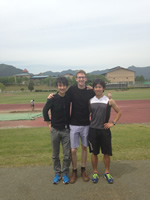
Friend Abroad: Taka-san, Yutaro-san (host brother), and I saying goodbye.
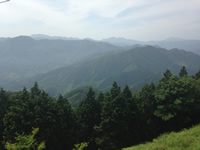
Gokase: A picture showing the natural beauty of Gokase.
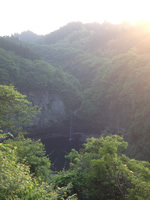
Waterfall: A beautiful waterfall that was a five minute walk from my home stay house. It is notorious for the number of suicides that occur there.
Overview of Orientation Program in Tokyo
The most helpful activity of the Tokyo Orientation was the entire Kyushu trip. It was great because it was the best chance to truly bond with KIP Japanese students which is important to getting an understanding of Japanese culture as well as generally having fun. It was also a rare chance to see a more traditional and natural side of Japan.
The least helpful experience was the first couple [of independent] outings we did out into Tokyo. We hadn't really realized that it is necessary to have a definitive plan of what to do in a district. Although it can be fun to just explore Shinjuku, I think it is better to go there with a particular activity in mind.
The most helpful part [of the language classes] was the review. The language class moves very quickly so it is hard to keep up with everything. I believe, although we would have complained about it, it might have been advantageous to have short quizzes at the beginning of class that would have forced us to accomplish memorizing a certain amount of vocabulary. To help study Japanese, I made sure I used it whenever possible and appropriate, even with other NJ students. I reviewed the previous days lessons while walking to class as well as after class each day. I also have found it helpful to test myself when to use which particle, as this is something I struggled with.
The most important thing that I now know is that I am capable of living independently in a foreign country. I realize that to a very large extent I have depended on Packard-sensei and the NanoJapan Program, but I do believe from this experience that I would be capable of living and studying abroad. There are however more things that I would like to learn. I am often amazed as to how efficient and “well behaved” Japan is. Speaking with the KIP (Japanese) students it is clear that nearly everyone from their high school classes graduate, while at many U.S. schools graduation rates can be as low as 50%. I would like to pinpoint why exactly it is that Japan is so successful in this regard. I would also like to gain a better sense of the Japanese attitude towards homosexuality while in Japan, and what effect it has on your status in Japan. Speaking with the KIP students it seems to be seen as something funny, but I am unsure if this is due to language barrier. Finally, I would still like to gain a better sense of what it is like to be a graduate student in Japan, particularly at OIST.
Intro to Nanoscience Lectures
Stanton-sensei's first lecture focused on semiconductor optics. He first explained that photons and phonon act as the smallest unit of energy for light and sound respectively. He then explained how everything has a de Broglie wavelength, but only for electrons is it large enough that quantum mechanical phenomenon can be observed. He went on to introduce the “solid state theory of everything”. This equation factors in many different factors and effects to determine the energy of a bulk material. Depending on the desired accuracy, different components will need to be included such as the many body problem due to interactions between electrons. The rest of the lecture went on to describe semiconductor mechanics and bandgap theory. He also gave a couple applications of semiconductors such as LEDs, Solar Cells, and generally junctions.
Stanton-sensei's second lecture focused on femtosecond spectroscopy. First he explained the difference between continuous and pulsed lasers. He then gave a description of just how short a 10 femtosecond pulse is. It is because of this short pulse the the interactions of the electrons can be measured due to the speed at which they move/relax. Femtosecond spectroscopy employs a pump pulse to excite the sample and then the probe pulse to measure the sample a very short time after it has been excited. He also gave a description of the gun affect, as well as how THz can be produced within a semiconducting material.
Otsuji-sensei gave a fascinating talk on his work to produce THz from graphene. His results showed seemingly small gain of only 2.3%, but if one considers the fact the graphene is only one atomic layer thick, this is extremely impressive. He believes that if the light could have more time to interact with the graphene, a much larger gain could be accomplished. To accomplish this, he plans to try to convert the photons to slower moving surface plasmons prior to interacting with the graphene.
This past week at OIST I have mostly been left in awe at both the resources and community. The first night Talapatra-sensei took Julianna and I to the main building of the campus. Walking into the building felt like walking onto the set of a science fiction film set. The main hallway currently has an exhibit of Nobel laureates holding self-drawn pictures of their work. The campus seems to breathe intellectual thought and research.
My first day in the lab mostly consisted of an apartment orientation and meeting the members of Dr. Dani's lab. The apartment housing is fantastic. We are lucky enough to live in brand new apartments that are furnished, have full kitchens, and even washer/dryer machines. I share the whole apartment with two roommates: Eren from Turkey and Moodit form India. The commute to my lab is about a five minute walk. The housing is luxurious and convenient compared to my university housing at Tulane. The apartment orientation taught how to use the Japanese appliances as well as fill out some paperwork. The first thing I realized when meeting the members of the lab, was the national diversity. Everyone seemed to be from a different country. Initially I thought this might just be unique to our unit, but I soon realized that the PHD students, interns, and professors composed a very diverse group. Luckily for me, English is the language that is common among us all, and is therefore exclusivity used.
Our first day was actually quite an important day for the lab because a new laser had just arrived and was being installed into the Magnet Lab. E Laine is the PhD student setting up the magnet lab, and is also who I will be working under this summer. E Laine is very polite and brilliant. She seemed glad that I didn't need too much assistance and appears to be very busy with setting up the laboratory. She is always very helpful though when I do need her assistance, or directs me to the right resource. I feel very lucky to be able to work under her guidance this summer. Everyone else in the lab has also been very nice and helpful. The first night we had dinner at Talapatra-sensei's apartment and Pete, a postdoctoral student joined us. I haven't spent much time with anyone else, but I am excited to get to know everyone better. I think, if anything, the formality that I was suggested to use initially was seen as being a bit odd. Because it is an international lab, nobody uses san for names. Additionally no one dresses as formally as on mainland Japan, and shorts are not uncommon.
As far as my project is concerned, the first day was mainly orientations. The second day however E Laine mentioned that I would be unable to begin working until the laser was completely installed in the magnet lab (a one week process). I was told to email Dani-sensei for reading or other work I could do in the meantime, and he suggested to begin building the spectrometer using a visible beam on a breadboard in another laboratory. This is primarily what I have worked on for the first week. It, however, was not as straightforward of a task as I had initially intended. Due to logistics, as will be discussed in the research report, I had to make some changes to my initial design of the spectrometer. Luckily Pete, E Laine, and Bala were all very helpful in answering any questions I had.Dani-sesnsei also gave me a deadline to finish the spectrometer by June 25th. I believe I should be able to accomplish this task. I do however, look forward to meeting Dani-sensei this coming week. I am excited to hear what he would like me to do for the remainder of the summer.
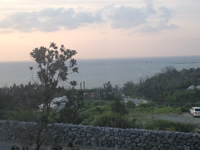
Dining Room View: The view from our apartments dining room table.
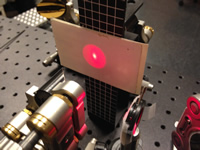
Laser Flag: As I was aligning the parabolic mirrors for the spectrometer I noticed the Japanese flag appear.
Research Project Update
The first component of my project is to build an optical pump terahertz probe spectrometer. One caveat is that Dani-sensei wanted the spectrometer to be as compact as possible. As such, I am using two inch focal length parabolic mirrors and a small translational stage. Because the new laser is being installed, I instead have built the spectrometer on a breadboard which will later be moved tot he magnet lab. The main goal is to have a functioning, compact, optical pump THz probe spectrometer.
First I will make the spectrometer without the pump beam and in transmission configuration. I have already begun this process in another lab using a red laser pointer. Shortly after beginning the work, I realized that although everything appeared to fit on my CAD drawing, the stands of the mirrors take up room and I had not accounted for the purge box. Additionally, I had originally planned for the gating beam to travel through a hole in the fourth parabolic mirror, but because the spectrometer is compact, the parabolic mirrors are one inch, so drilling hole would be unrealistic. Instead we were going to use a pellicle after the last mirror; however because it needs to be two inches from the ZnTe receiver, there is not enough room. To remedy this situation, I instead will use an 8 inch focal length (depending on availability) mirror for the last one which will allow enough room for the pellicle to be placed. However, due to the larger focal length, the focus of the beam on the receiver will not be as concentrated. Because of this larger size, I had to rearrange the spectrometer layout and as a result it is slightly larger than initially planned, but ultimately still very compact.
The spectrometer will use a delay stage connected to a motion controller to step the gating beam along the THz beam. It will also use a lock-in amplifier with a mechanical chopper to measure the signal from the balanced photo diodes. The photo diodes measure change in polarization of the gating beam that is a result of the Pockel's effect inside the ZnTe, where the THz acts as the electric field. A Wollaston prism and a quarter waveplate will be placed before the photo diodes to split the vertical and horizontal polarizations of the gating beam. The 2.8 Watt 50KHz laser will be be split into the gating and generating beam by a beam splitter such that the generating beam contains the majority of the power. After initially aligning with the visible beam, the spectrometer will be placed on the table. Hopefully, some amount of THz will be able to be measured. From there, the signal can be maximized by adjusting the optics. Next the spectrometer will also be aligned for a 45 degree reflection off of the sample. Finally the pump beam will be introduced. The primary training I will need is just the laser safety training specific to my host lab.
Prior to coming to the current final design, I had thought about a number of other methods to make the spectrometer as compact as possible. One idea that I had was to have the gating beam come in the opposite side of the ZnTe reciever than the THz. This would allow the 2 inch focal length parabolic mirror to be used with a pellicle between he third and forth mirrors. However, after talking with Pete and E Laine, I decided it would not be a good idea as I am not entirely sure if the electro optic sampling could still occur in the same manner as the THz and gating beam wouldn’t be traveling through the crystal together. After I complete the spectrometer by the 25th, I will likely take measurements on Titanium Dioxide samples for the remainder of the summer. I have done this previously, but at Tulane I took ellipsometry measurements, so the data analysis will likely be different. I will likely have to use MatLab. I am excited at the chance to further practice and learn MatLab.
I also underwent an orientation of the clean room this first week with Julianna. It is unlikely that I will need to use any of the equipment in the clean room, but it was still very impressive nonetheless. The clean room supposedly can count as few as a couple hundred particles per cubic foot. Additionally the clean room has a very nifty new photo lithography machine. This lithography machine does not use photo masks, but instead can take a CAD drawing and uses mirrors to project the image onto the substrate. It still however can maintain micron resolution.
I have also noticed that much of the femtosecond lab's past work has been involved with THz measurements that use a much larger bandwidth of the THz spectrum (up to 30 THz). For this reason, the lab has lasers with some of the shortest pulse lengths. Shorter pulse lengths are needed to measure farther into the frequency spectrum because of uncertainty between time and energy/frequency.
My cultural misunderstanding combined three different cultures as well as a rushed environment to result a somewhat awkward situation. My first free Sunday, I went to a nearby beach with Julianna, her roommate Sheila from Oregon, my coworker Sid from India, as well as two other students from Sid's same program. I had not yet received my OIST drivers permit to rent the cars, so we decided to take the bus instead. From my bus ride to OIST from the airport I learned that Japanese buses do not have you pay as you board, but instead give you a ticket with a number on it. The number corresponds to a price that you can read from a board to determine how much you must pay. Additionally, you are expected to pay with exact change, or use the change machine available.
On the bus ride there, Sid had been the first to exit the bus, and he was kind enough to pay all of our bus fees at the same time and we paid him back later at the beach. I was a little confused with this way as we did not each give the machine the ticket, but the bus driver seemed ok with this setup. On the bus ride back to OIST I was the first one to exit the bus. I had concluded from the bored that my fee was 160 yen. I quickly put my ticket and money into the machine and began to step off the bus. However, the bus driver stopped me and I heard him say “ni-hyaku” I knew this to mean two-hundred, so I attempted to put in 40 more yen. Meanwhile Sid was telling me just to put in enough money for everyone and they could pay me back later. The driver was still unhappy with the 40 yen, so instead I just gave a 500 yen coin to Sheila who was behind me and told me she knew what to do. She ended up taking my 500 yen and adding an additional 1660 to pay for everyone. Later she explained that the price was 360 per person and he was trying to tell me 200 more yen.
I first realized there was a misunderstanding when the bus driver stopped me. I realized the second misunderstanding when Sid ask that I pay for the group. In both cases the misunderstanding resulted from me not being observant enough. If I had paid closer attention when exiting the bus on the way there, I could have seen how to correctly read the board. Also, if I had thought about it more, it would have been clearly polite for me to offer to pay for everyone, as that is what we did on the way there. I primarily think I was tired from a long day of beaching. Putting myself in the bus drivers shoes, it was simply a case of wanting to be paid. For Sid, it was just the case of wanting to save time for the group. In retrospect, this situation wasn't as much of a cultural mis-communication as it was just me not being as observant as I could have been. On the otherhand, I suppose the way Sid approached the situation was more of a group mentality that I lacked. I was also relying too much on past experiences from bus travel in the US. At least in New Orleans, it is just a flat fee regardless of destination which makes it somewhat simpler. In the end, nothing negative resulted from this mishap, except for me looking like a confused foreigner, which I suppose I am. I am thankful that Sheila stepped in to simplify the situation. Next time, I will try to pay for the group, as it does make it quicker. I will also pay closer attention to how to read the bored.
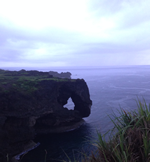
Cape Manzamo: A famous cliff on a cloudy day.
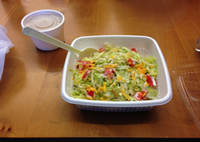
Taco Rice: A popular “mexican?” influenced dish.
Research Project Update
This past week has largely been spent making fixes to unforeseen problems of the spectrometer. The first problem that was faced was how to get the gating beam to hit the ZnTe with the THz. The consequence of the short 2-inch focal length parabolic mirrors was that there was no room to fit the one inch pellicle that was bought. To remedy this situation I decided to use 3-inch parabolic mirrors for the first and last parabollas, as well as order a slim pellicle stand to fit in between the three inch parabolic mirrors and the ZnTe crystals. Meanwhile I have also contacted a local tech company to drill holes into two of our 2-inch parabolics. Using holes in the parabolics would be preferable to the pellicle because the pellicle can introduce noise due to vibrations in the film. If the holes cannot be drilled in time for the conference though, then the spectrometer will be built using the pellicle.
Another issue that I ran into this past week was figuring how to fit the purge box around the parts of the spectrometer where THz will be emitted. Initially I had planned to use metal posts a the corners of the purge box, as many other spectrometer in the HE and Microscopy labs use. Pete showed me that instead the box can be made just by gluing sheets to each other. This has saved me a ton of space and flexibility in my design because now the box does not need to run along a line of holes. Pete and I will go to a local hardware store soon to pick up the acrylic sheets to make the box. Between the parabolics, I also spent a lot of time realigning how the stages weave between each other, as well as how the stand for the sample will fit.
Finally, today I had to add four extra mirrors because, as Keshav pointed out to me, if I do not have mirrors before the delay stage, I must realign the whole spectrometer even if I only need to realign the delay stage. This was remedied by adding a couple of mirrors and slightly expanding the size of my purge box. The one downside is that now that the purge box is slightly larger, it will take longer to purge. The Laser was also finally finished this week. This means that I will be able to move my breadboard into the magnet lab. Before this can happen though, I need to gain access. The tech company said the holes in the parabolic mirrors should be done by July 1st, but I will go ahead and try to get a THz signal in the next couple days using the pellicle just in case. I don't anticipate it to be too difficult, but from past experience I also wouldn't be surprised to run into a couple more bumps.
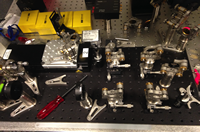
The spectrometer in an unfinished form.
Being in an international lab, the addition of -san to someone's name has taken on a new meaning. Instead of showing formality, I have noticed that the graduates and postdocs often add it as a way to lighten the conversation, or make it more playful. For example, if the conversation involved asking for an optic from another lab, the regular first name would be used. However, if someone was asking another what their weekend plans were or were making a joke, they might address using san. Tamaki-san, our lab's secretary, is an exception in that everyone uses -san. Regarding other aspects of day to day communication, it is pretty casual. Members will just walk into other labs and ask for a tool/optic and probably say thank you after, but there are no formalities that are strictly followed. I think if anything, I am still being too formal in the way that I address my lab mates, and instead could be more casual. The other exception is the way in that Keshav is addressed during a meeting. During a group dinner or something, he is addressed the same as every other member; however during a meeting his words are always listened to the closest and he is never interrupted or interjected into.
These interactions are entirely different from what was presented in the orientation lectures because it is an international lab. The hierarchical structure that was discussed might still be there but it is less pronounced. For the most part, the postdocs, graduate students, and even interns are addressed the same by both Keshav and the other lab members. The only difference is that the higher up you are on the hierarchy the more often you give input as you have more experience.
One thing that I have been adjusting to in my laboratory is the value of success. Hard work and late hours are looked well upon, but when it comes down to it the only thing that will make Keshav happy is results. This fact has been causing me some stress in the past few weeks. I am used to being able to put in hard work and have that be enough, but here the only thing that matters is that I finish building the spectrometer on time. I am not used to this, but on the other hand I think it is better preparing me for graduate school and research later on. It is great to put many hours and hard work into a project, but in the end if nothing useful is produced/measured, the work doesn't mean anything. It is however difficult because at times it feels that that it is out of my control. For example, I have had to wait for different parabolic mirrors to arrive for my setup, but in reality, if I had noticed the issue when I first arrived at OIST, then I could have already gotten the mirrors worked out and been ready to go. This past weekend, for example, I have been trying to finally measure the THz, but I am getting very large noise from the laser/photo diodes. Again it feels out of my control, but this is a lesson in research. Because it is my project, I am the one that needs to push and find a result. It is ok to ask for input/help, but in the end it is under me to get the finished spectrometer working well before the mid meeting program.
My lab at Tulane is much smaller, only 4 members including myself and Dr. Talbayev. In this way, the graduate students and I work much more closely and we go to Dr. Talbayev when we get stuck. We also help each other out more with each others project and it feels like more of a group effort. Here at OIST, each persons project is more of their own. Help is still asked for and given, but in the end each individual has their own work. Also, instead of going to Keshav, I have graduate and post doctoral students to go to for help or suggestions before I need to go to Keshav. I think I do prefer the environment of my lab back home, but on the other hand I believe this order is much more productive.
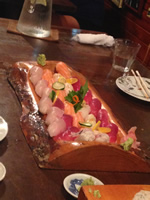
Sushi Out: Fantastic sushi that we ate on our lab's night out.
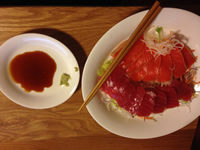
Sashimi In: Delicious sashimi I got from the local grocery store.
Research Project Update
This past week I finally moved my spectrometer to the Magnet Lab which will be its final resting place. I unfortunately made a mistake previously in my plan however. I had anticipated using three inch parabolics that I could use to fit a pellicle in with the new stand. However, I was misreading the box and misread the three inch parent focal length for the effective focal length. Because of this, I have decided to use the six inch parabolics but move them off of the bread board onto the table. This will only be a temporary setup until the parabolics with the holes arrive.
The first issue with the settup in the magnet lab was figuring out how to get the beam from the laser to my setup. Currently E Laine is setting up a “Zues” system that will produce high energy UV light, but because of this, there is no clear bath for the beam to reach my spectrometer. To fix this a have used a set of periscopes to jump over the Zues setup. Aligning the periscopes was a tricky process as it is very dangerous to have the beam being moved vertically. Next after the periscopes, I had to telescope the beam down from the original 4mm diameter size to nearly 1mm diameter. This was difficult to get the concave lens in the right spot so the beam stayed near the correct size. Ultimately I got it down to 1mm and 1.5 mm when it is about a meter from the telescope, but some of the increase in size could be due to dispersion. Using the new beam I realigned the spectrometer. I also put the chopper and connected it to the lock in amplifier. The chopper is chopping near its highest frequency at 4.4KHz. This is to approach the very high repetition rate of the laser.
In addition to the physical changes that I made to the spectrometer, I also spent a good amount of time working with the software to make the THz measurements. I will be using the same LabVIEW program that the neighboring High Energy lab uses. My first challenge was to settup the motion controller so that I could talk to it through LabVIEW. The motion controller is connected to the network, so it can be communicated to remotely. To do this I had to assign it an IP address as well figure out how to input into LabVIEW so that it would be able to talk to the controller. Additionally I also needed to figure out how to communicate with the lock-in amplifier through GPIB. Initially I tried to use a very cheap (not national instruments) GBIP to usb device. After much struggling, I discovered that to be able to communicate with the device, the LabVIEW program itself wold need to be changed as it does not communicate by the standard VISA commands that National Instruments usually uses. Instead I am currently borrowing a NI GIBP controller from the Microscopy lab while we wait for a new controller to arrive.
On Friday I met with Keshav, as he is getting concerned that I will finish on time. We double checked the powers that I am using and discovered that what I was using not close enough power to generate THz. To counteract this, for now, I will divert the entirety of the beam (without pump beam) to the spectrometer. This weekend I realigned the system using the entire beam but noticed a couple of unfortunate things. The periscopes seem to be greatly reducing the power. I tried cleaning the mirrors, but this didn't seem to have much of an effect. I have also noticed that when the beam is reaching the photo diodes, I am not getting a steady signal at all. I tried focusing the beam size down a little bit, but the re still seems to be a very large amount of noise. I believe this might be due to the laser itself, but I am unsure. I will talk to Keshav and E Laine about it.
I am pretty far behind on the anticipated time line that Keshav and I had initially discussed. We had originally planned for me to have finished the spectrometer by this week, but at this point I find that unlikely. I found THz, but now I need to move the setup to the new lab and have it built with the new parabolics as well as add the pump beam. I feel that I am working hard, yet it is just taking longer than expected. This has been giving me stress, but I think I need to learn from this that research often doesn't work as easily as initially planned. I will definitely finish the spectrometer, but I am unsure if I will have time to take measurements on a sample as was initially anticipated.
This past week has been a scramble to produce THz before the NanoJapan students come and before the conference on the 11th. Because I was still struggling to get low noise measurements from the spectrometer, Keshav had Julien, a postdoc who just returned to OIST, help me with my setup. We began working in the magnet lab and Julien was having as much trouble as I was. We were making small adjustments to my setup, but ultimately Julien was still confused as to why we weren’t seeing THz and why the magnitude of our noise was so large. The Wyvern laser that we were using was having fluctuations in its power, among other temperature issues. We concluded that the difficulty to finding the THz could be a result of the laser.
To fix this I moved the spectrometer back to the HE lab, so we could try to find THz using the Spitfire laser. We were anticipating the parabolics with the holes to arrive, but the company drilling the holes into the parabolics said they were very busy, so we would need to wait until Friday to receive the parabolics. So that I wouldn't need to wait until Friday, I came up with the idea to place the pellicle between the third and fourth pellicle and introduce the beam there and have it reflect of the last parabolic mirror and focus it on the ZnTe. Although this idea is not ideal because it prevents the last parabolic from being optimized, it would allow us to find the THz more quickly.
After moving to the HE lab and setting up the new setup, Julien once again helped me trouble shoot. We tried adding lenses to focus on the emitting ZnTe and the photo diodes. Ultimately we also greatly reduced the power of the gating beam so that we did not receive the overload message on the lock in. After reducing the power on the photo diodes, and making sure the beam was well focused on them, to my surprise we finally measured the THz.
It was now time to maximize the signal. I first slightly altered the current LabVIEW program so that it displayed the previous 4 scans. This would allow me to see if adjusting a given knob resulted in an improvement of the signal. I made my way adjusting the positions of the different optics as the signal increased. I repeated with all the optics multiple times, starting farthest away from the photo diodes and working closer. The signal increased quite a lot. I succeeded in producing the THz prior to the arrival of the NanoJapan students (although this is nothing compared to Nicole's two days :)).
Next week I will move the system back to the Magnet lab, as well as change out the parabolics for the ones with holes. E Laine has succeeded in stabilizing the power, so this should no longer be an issue. I will also need to add a pump beam as well as use another delay stage for the pump. I will also need to start planning the construction of the purge box.
This past week we also prepared for labtours for the NanoJapan students as well as a large conference next week. Some of the biggest names in THz science will be coming and we want to show the capabilities of the labs. I will be giving a short synopsis of my summer work as well.
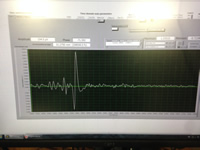
First THz: The first THz waveform found by my Spectrometer.
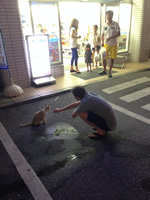
Okinawan Friends: Ben10 making friends with a local.

At the end of the orientation, I felt accomplished with the amount of Japanese I had learned. I felt that I could communicate very basic ideas, but more importantly I could often understand the very general direction of conversation from a native speaker. Unfortunately, my Japanese progression has greatly slowed during my time working in the labs, and I am afraid I have also forgotten much of what I had learned. When I do try to speak with people in town, or when buying lunch, I struggle to find the correct words and have to think a bit longer than I did right after the orientation. I do regret not taking the courses that OIST offers, but from what I have heard they don't help too much as they usually only meet once a week for about an hour. I have generally also found it difficult to self study as I have been so busy, and because Japanese is not necessary on day to day basis, the motivation is less.
So far my most challenging linguistic experience was at the grocery store. I was trying to figure out which carton was the soy milk. After trying to read the Japanese on a number of cartons, I decided to ask for the help from a clerk. Initially I just said soy milk in the hope that the katakana might be similar, and she would be able to understand, yet she was still confused. After thinking for a while, I said “tofu no miruku” which I tried to mean the milk of the tofu. She then brought me to the tofu section and pointed to the array of tofu's. I then tried pointing the the array of cartons, first pointing to the cows milk and crossing my arms to show that I didn't want cows milk, but repeated tofu. Finally I was able to demonstrate what I wanted and she directed me to the correct cartons. I was still unsure if I had in fact bought soy milk, but I was happy once I got home to discover that I in fact had.
Although there is little Japanese at OIST, when I am at the grocery store, I do try my best to read the Hiragana, Katakana, and Kanji that I do know. It is a good opportunity to challenge myself to figure out what is inside the array of can a bottles. It is also fun as I later discover if my assumptions of the contents are correct or not. I have grown an appreciation for the Japanese language however. Japanese is a beautiful language both in the way that it is spoken, as well as its written form. It is also interesting to think that now as China is beginning to almost exclusively use simplified characters, Japan and Taiwan are the only countries that will continue to use the characters in their older form. A lot of the meaning is lost in the transition to simplified characters, which is sad. For this reason I am motivated to learn some of the kanji so as to learn the characters in their full meaning. I would love to be able to take a Japanese course once I return to Tulane; however in reality I believe it will be unrealistic with my current schedule. I would like to become as dedicated as Chris is and self study. I think that I will ask him for some tips.
The Mid-Program Meeting program was extremely reassuring. I went into it still feeling a bit overwhelmed with my project and research in general, but after talking with the other NanoJapan students it was comforting to hear that my struggles were not uncommon. After the program, I was also looking at the NanoJapan website of alumni, and was happy to see my exact feelings summarized by Nathan Brooks “Through my hands-on research and conversations with the members of my NanoJapan lab, I knew when I applied to graduate school that I would face many obstacles: - Unpredictable and long hours - No guarantee of (forward) progress as a function of time spent in the lab - That progress often means analyzing your test results and discovering that what you have spent a great deal of time on is not a viable solution”. Hearing that someone else faced similar difficulties and then learned from them really caused me to take a step back and appreciate the experience and what I am learning from it.
Research Update
This past week I was preparing for the Ultrafast Satellite Conference that would be held at OIST. I wanted to finish my spectrometer prior to the conference, so I worked hard to get the THz with the drilled hole parabolic mirrors. After putting in the new parabolic mirrors, the beam path lengths changed, so I had to change the paths and add some mirrors. The Telescope wasn't bringing the beam to a small enough size, and if I used a longer focal length for the first lens, I found that due to the high pulse energy of the spitfire, it would begin to ionize the second lens if it was near the focus. Instead, I decided to use a long 1000mm focal length lens which worked quite well. After some adjustments, I was finally able to measure THz. I then move the setup back tot eh magnet lab as well as added the stage and mirrors for the pump beam. Unfortunately, the Wyvern laser in the Magnet lab was having issues after the Typhoon, so I was unable to realign the spectrometer using the Wyvern. Ultimately, I was able to show the spectrometer in what would be its final resting place as well as show a THz waveform that I had collected to the scientists for the ultra fast conference.
The Ultrafast Conference itself was a true treat for me to be able to experience. I have not previously attended any sort of conference besides the occasional talk at my university. Some of the biggest names in ultrafast phenomenon were there: Phil Bucksbaum, Margaret Murnane, Keith Nelson, Charles Schmuttenmaer, and the list goes on. It was exciting to here them present their work, but the even better part was the setting of Okinawa allowed for external discussion to get to know them as people as well.
One of my favorite talks was Margaret Murnane's. She discussed how extremely short pulses could be generated by higher harmonic generation using longer wavelengths of light. Rohit Prasankumar than suggested with a question of the possibility of higher harmonic generation using Terahertz to produce extremely short high frequency pulses. The limiting factor that Dr. Murnane gave was being able to produce enough THz in high enough power. Jerome Tignon also gave an interesting talk in which he discussed THz generation using quantum cascade lasers. He stated that quantum cascade lasers can produce THz to an amazing 1 watt of power. Charles Schmuttenmaer also gave an interesting talk of THz conductivity measurements. Ultimately, it was a very exciting and intellectually stimulating day.
After the talks, we all had sushi together in Kaito cafe. After dinner I had the chance to have a short conversation with Phil Bucksbaum. We discussed his favorite undergraduate courses (many taught by famous scientists of the past) as well as the future of OIST. Perhaps my favorite part was discussing Phil's views on the more philosophical aspects of quantum mechanics. We discussed the axioms that he personally believed as well as what it means to be an observable and even what it means to be observed/measured. It was a pleasure to have this type of discussion with someone so brilliant.
The next day, we all traveled to Iejima Island together. We had lunch, went swimming, and also climbed to the top of the mountain. On the way up I talked with Charles Schmuttenmaer about his past work with my P.I. at Tulane (Dr. Talbayev) as well as the atmosphere of his research group and research groups in general. I also talked with Rohit some more and he gave me good advice that I believe is good to follow: “Don't work with one group for too long, experience as many scientific different points of view and cultures as possible”.
Ultimately it was a weekend that I don't think I will ever forget. It also reaffirmed me in my desire to go to graduate school and someday be able to play on the same intellectual playing field.
Obokata had been a successful scientist throughout her career, one article stating that she was asked to stay at Harvard due to the quality of her work. She seemed confident that she had made a breakthrough, so she tried to get it published in Nature. She was having great difficulty though. A comment from a show host regarding her being a rijeko brought her into the media. People were focusing on her dress and looks rather than her science. She was then published in Nature. Shortly after it was accused she falsified data/info. Riken held a hearing and agreed it was misconduct. Obokata pleaded that she could recreate the results, but other scientists were unable to recreate. She apologized, and Riken refuses to reconsider. She was not given another chance.
I believe that the most important issue is the fact that misconduct can so easily be accepted into a top journal. There should be abetter system of quality control. Additionally I believe that the issue of gender is worth bringing up. It is sad that all that society mostly cared about was her gender, and it seemed that this caused her a great deal of stress possibly contributing to her mental health/health issues.
As stated in one article, I believe pressure to publish did have a large affect on her as she stated that she rushed putting the paper together to get it out before anyone else. No one can yet say for sure if it is true that it was unintentional. Either way, it still seems that there is a chance that the results could be validated, in which case it will likely save her career as pressure to publish and sloppy editing is a reasonable excuse. Gender also played an interesting role. I believe that in the scientific community she would have been treated the same regardless of gender; however I believe that she did have the additional stress of becoming almost a celebrity in the eyes of regular people.
The thing that I am most shocked about is how it does not seem that there is any effort going into trying to get the results again. Science is science and people make mistakes, in my opinion it doesn't matter so much if parts of her work were misleading or falsified as long as the results were correct and stressing cells is a viable way to produce stem cells.
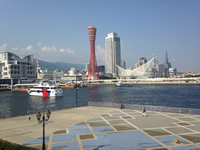
Kobe: A view of the Harbor from Harbor Land
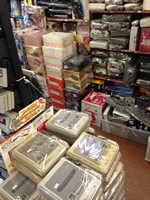
Old School so Cool: A vintage gaming store in Osaka
Research Update
After the Typhoon the Wyvern laser in the magnet lab was not working correctly due to the chiller. When the laser first arrived a component was missing, they had promised to replace it, but as it had no immediate effects on the operation of the Wyvern, we operated without it, but it is now affecting it to the point where it will not turn on. Because there is no laser in the Magnet lab, I moved my setup once again to the HE lab. The plan is to build the purge box and compare purge times to that of a larger spectrometer, as the small size is what makes my setup novel. I have had to readjust some of the components to make room for the purge box walls, and I will now have to realign, but I don't expect it to take long as the parabolic are already aligned and I know what to adjust to get THz. I also now have the acrylic walls for the purge box and have measured the dimensions of the purge box. I will cut the walls next week using a jigsaw as well as drill holes for the generation and gating beams.
Because I do not have too much work left for my project and still have three weeks left, I requested to work on a project that I knew Keshav had wanted someone to start. While Keshav was visiting my home university, Tulane, he received three unique samples that he wanted to make kerr rotation measurements on. The materials are MnPS, NiPS, and FePS. They are 2-D layered materials where each layer consists of triangular planes of phosphorus, followed by a metal followed by sulfur. They are expected to have interesting magnetic properties that we would like to explore optically. Initially Keshav was told that the samples would likely be ferromagnetic, and are new in that they have no previous literature. We began by wanting to take magnetization measurements using the physical properties measurement system (ppms) to see how viable kerr measurements would be. We used one of the FePS samples as iron is usually more magnetic. However when we took the measurement, we did not find the hysteresis loop that we were hoping for. We cooled to lower temperatures and only then saw a slight slope. But after removing the linear component, what could be a loop appeared but it was still very week even at 5K. Meanwhile I learned how to take raman and photoluminesence measurements and measured all three samples. The Fe and Ni samples both displayed a broad photoluminesence spectrum suggesting an indirect bandgap. The Mn however had a large peak (still fairly broad) which might point to a direct bandgap. The raman spectrum all showed many features, but must be analyzed further.
We had a Skype meeting with my professor back at Tulane to get more information. We then found out that they had actually found a little bit of background literature from the 1980's. Turn out that they deduced that the samples are strongly insulating and antiferromagnetic at sufficiently low temperatures. We then decided that it would be beneficial to look further for more literature. Jerome and I quickly found a number of other publications that dealt with these materials. They gave some usful information regarding the structure as well as basic properties. One of Keshav's original ideas was to reduce the thickness of the sample until it reaches monolayer and see how its physical properties change. This was inspired from the Dani Unit's past work with MoS2 where an indirect bandgap became direct from bulk to monolayer. We found one theoretical paper that used density functional theory to model these materials responses to becoming monolayer. There was also one source tht cited that they had successfully synthesized monolayer MnPS. Regardless, opto-magnetic measurements have yet to be done on these materials and kerr effect experiments could yield some interesting results. Jerome and I built the basics of a MOKE/Faraday effect measurement system. It employs balanced photodiodes to measure the change in polarization after passing through the magnet/sample. The system uses a HeNe continuous laser and we are hoping the signal will be large enough to not require modulation.
Sakurako-san has had a very unique undergraduate and graduate experience so far. She attended undergraduate in Scotland and then returned to Japan to complete her PhD at OIST. She commented that she was fond of her undergraduate studies abroad. From what I have learned talking to KIP students, studying abroad for undergraduate is quite uncommon. This could possibly be connected to the fact that Japanese often prefer the more standard traditional route which is attending university inside of Japan. After undergraduate Sakurako-san again choose the road less traveled by most Japanese students by attending OIST. Although OIST is an extremely impressive and well equipped university, because it is new and has not yet become famous, many Japanese students are less inclined to attend when they can instead attend a well known university in mainland Japan.
Sakurako-san also mentioned that she had used her yearly OIST trip (OIST grants one paid trip to another university/country per year) to go back to Scotland. Sakurako-san clearly realizes the value of international learning and making global connections. She also mentioned that she was quite fond of the international community that formed at OIST. She said that her and the other PhD student had become very close. I got to witness this first hand after attending her birthday party a couple of weeks after arriving at OIST. Her fellow students threw her a very nice party and they seemed like a very close group. They had all brought a range of foods and treats that they had for the most part made themselves. It was a very unique experience to see so many people from different backgrounds and cultures come together in one extremely diverse group. In many ways it reminded me of our own NanoJapan group. It is a good message that there are really no cultural boundaries that are too large for friendship.
Another interesting topic we discussed was the curriculum and research program of OIST. During the first year and a half at OIST, all of the PhD students must make rotations between three different labs, and one of the labs must be very different from your intended area of study. Sakurako-san came to OIST wanting to work in a Neurobiology unit.
Because of her rotations though, she ended up working in a Physics unit for a semester. She said that she had very limited knowledge in Physics and therefore initially felt unprepared. She ended up preparing a material that required her to carefully grind to make powder. After some time doing this, she came up with a method to instead use a blender which turned out to greatly simplify the process. This goes to show that it is possible to still have a helpful impact without having an extensive background in the work.
The neurobiology (Wickens) unit that Sakurako-san is now a part of investigates the mammalian brain on a cellular level. They attempt to understand the exact roles that dopamine and acetylcholine play in the brain. Sakurako san was mostly interested in what Julianna and I had done and seen in Japan and Okinawa. She gave great advice on what to go see and do. We were going to go with her to the local farmers market with her later in the summer, but unfortunately we ran out of time. It was great to get to know Sakurako san as well as gain an insiders perspective of living abroad as well as being a student at OIST.
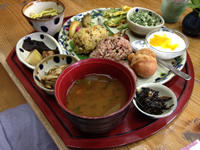
Longevity Meal: A traditional meal eaten by the people of Ogimi. Ogimi has the highest longevity index in the world. The meal
consisted of a lot of goya, miso, and seaweed. It was fresh and delicious.
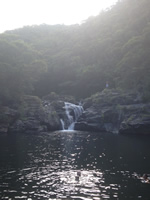
Afternoon Dip: A waterfall with a swimming hole we stumbled upon.
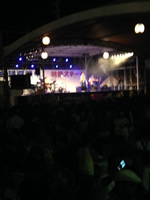
Surprise Concert: A concert we found in Nagofor the summer festival.
Research Update
This past week I have continued to characterize the antiferromagnetic materials from Tulane as well as work on the purge box for my spectrometer system. Early in the week, we had another meeting with Dr. Talbayev from Tulane and discussed the materials and what measurements to make. We looked at the photoluminesence spectrum again, but were confused because they did not seem to mach the band gaps that previous work had determined. We also realized that the excitation laser of the raman is 532nm which is lower energy than the suggested bandgaps for nearly all of the materials. We concluded that it is possible that two photon absorption is occurring and the peaks that we were seeing are second order. To test this theory, we agreed to repeat the photoluminescence but vary the power. If it is two photon absorption, then we would expect to see a quadratic relationship between the counts and the laser power. We also agreed that we should take UV-Vis measurements as soon as possible to further characterize our samples before attempting the MOKE measurements.
Making the UV-Vis measurmenets sounded easy in theory, but turned out to be slightly more difficult than expected. My initial plan was to mount one of the samples onto a glass slide and place the slide into a cuvete that could then be measured by the UV-Vis. I first zeroed the instrument using just the glass slide with a piece of double stick tape. I then placed on of the MnPS samples onto the double sided tape. I then tired to measure the sample, but received an empty spectrum. I concluded that the UV-Vis must use a narrow beam to measure and it was probable that the beam was not hitting the sample. I tried moving the sample several times on the cuvete, but still no luck. At the end of the day, I tried tot hen remove the sample using tweezers from the double sided tape. To my dismay, the sample very easily ripped (similer to how gold leaf rips/breaks). I salvaged about three pieces from the tape that were of reasonable size, but I was still pretty down. Fortunately we were given two of each sample, so we still had one large sample and the small pieces from the ripped sample could still be used later on for other destructive measurements.
Following this, I then looked up the beam height for the UV-Vis. It turned out to be 8.5mm from the bottom of the cuvete. I then again attempted the UV-Vis measurement, with the help of Jerome, and put the sample at the correct height. We finally measured a spectrum and it matched to a spectrum found in another paper. We however were hesitant to measure the other samples as we were concerned that the tape could damaged one of the other samples as well.
Our next goal was to figure out a way to mount the samples inside of the 17T magnet. The sample holder for the magnetic accepts a 1cm diameter disk that is 1mm thick. We decided to drill four holes into it, three for samples, and one as a control hole. I quickly sketched up an autocad design and Jerome and Tamaki san brought it to the machine shop to ask to get it made asap. We received the piece a couple of hours later and mounted the samples onto the disc using silver paint (good thermal conductor for when it is in the magnet). Using this mount, we then were able to take the rest of the UV-Vis Measruements.
What has changed the most about your perceptions and attitudes towards Japan?
When I first came to Japan my opinions were mostly based on how US media portrays Japan. This primarily consists of a culture that is obsessed with, anime, eats sushi, and is hard working. I have learned that although those are facets of Japanese society, they don’t show what the truly impressive and unique aspects of Japan are. The thing that has caught my attention and surprised me the most most are the subtleties and unique understanding that exists in Japanese communication. I believe it might be a result of the education system, but many Japanese seem to have similar views. Many Japanese explain that they can tell how eachother are feeling through subtext and without a lot of words.
What has changed the most about your perceptions and attitudes towards the US?
I believe that largely I took living in the US for granted. Growing up, my elders often complained about politics and other aspects of the US. From this point of view it is easy to expect how successful and impressive the US is. I was reminded of this fact when talking to other international students at OIST. For example, I've always taken having English be my first language for granted. Additionally, I was able to choose my major and area of study, whereas in many countries one is assigned what they study based on test scores. Oddly enough being abroad I would say has made me more patriotic, or at least thankful for living in the US.
What has changed, if anything, about you personally? Are you a different person in any way from when you first came to Japan?
I think I have become more appreciative of courtesy and respect. I care more about relationships and feelings among friends and family. I also believe I have come to feel more independent in that I have proven to myself that I can live abroad on my own.
What were the most common daily frustrations you experienced with living in Japan? What did you learn from these experiences?
At OIST, I didn't notice very many frustrations due to Japanese culture. However, during my time in Tokyo, the communication barrier started to become frustrating. I have taken it for granted back home how easily I can communicate, and I can get frustrating not being able to covey my feelings.
What will you miss most about living and working in Japan?
The general politeness and courtesy of the people. Everyone seems to truly care about the well being of the people around them. This can be seen in how people wear masks to prevent spreading of colds, as well as how people are generally very willing to help you.
How did this experience affect your attitudes towards academic research and your career goals?
This summer has definitely cemented my desire to attend graduate school. I realized halfway through at the conference at OIST that I wanted to be able to have scientific discussion like the other scientists at the conference. I have also generally enjoyed the process of devoting my full thought and energy into achieving a difficult goal.
Describe your final week in the lab. What arrangements have you made to say goodbye to and thank your research group or those who have assisted you during your stay at your host institution? Did you have a going away party?
Because Julianna, Sid, and myself were all leaving within a week and a half of each other, our lab decided to have one large going away party. We went to a traditional Okinawan restaurant and had a great time reminiscing of the summer. I also made an effort to say goodbye to the other interns in other labs that I had made friends with over the course of the summer. I also gave away my last gifts that I had brought from New Mexico. Gave one to Jerome Tignon, the french professor I worked closely with during the last three weeks, Julien Madeo, the postdoc who gave me advice fore my THz setup and E Laine Wong, the graduate student that acted as my mentor.
How did you close out your research project and do you plan to remain in contact with your research group and/or host? Do you plan to continue this research project or research in a related area upon your return to your home university?
I closed my project THz project by taking measurements of the purge times in the too systems. For the characterization of the antiferromagnetic samples, I made the past data easily accessible to Jerome as well as taught him how to operate the raman. I also Talked to Keshav, and he was in favor of me returning to OIST. At this point I plan to return to OIST for my spring semester and possibly my summer as well. I am very excited, but first I will have to acquire a visa.
What are your plans for your final weekend in Japan?
Spend time with Jade and Anni (kip alumni), go shopping, climb Fujisan!
Tokyo Research Symposium Overview
I found the Tokyo Research Symposium to be both interesting and informative. I was nervous to be the first NanoJapan speaker, especially because my practice talk in front of my group at OIST didn't go particularly well. I get quite nervous talking in front of groups, but I think my presentation went as well as it could have. I also particularly enjoyed hearing the other NanoJapan students talk about their experiences in a more formal setting. I think it also prepared some of us for the RQI poster symposium. The night before we practiced trying to give concise overviews of our research and in this sense it was good practice.
My favorite portions besides hearing the other NanoJapan students speak was the panel and Dr. Matherly's talk on the NanoJapan statistics. The panel was interesting to hear the same questions be answered from both perspective of the program, the students and the mentors. The statistics given about the NanoJapan program really drove home the importance, significance, and effectiveness of the program. It really helped to show that international research abroad really does give enhanced benefits to just working in the US. It was also interesting to hear from eh NSF point of view why international experiences are important. I thought that Dr. Mittleman's talk on THz was engaging and clear, but I don't think it was entirely necessary. I felt that most everyone there already knew that background and those who didn't were less interested in the science and more so in the international aspect of the experience.
Final Research Project Overview
Projet Title: Construction and Calibration of Compact Optical Pump Terahertz Probe Spectrometer
Research Lab: Femotosecond Spectroscopy Group, Prof. Keshav Dani, Okinawa Institute of Science & Technology
Introduction: Optical pump terahertz probe spectroscopy allows one to explore the conductivity dynamics of a material on the sub-picosecond timescale after optical excitation. Based on the transmission of the THz probe through the sample, one can deduce useful information regarding excited carrier dynamics. This poster will show the validity of using a compact spectrometer design to make THz spectroscopy measurements. The system can be used in both a low repetition high energy system, 1khz 5W system, as well as a tunable high repetition high energy, 50-100Khz 10W. The optical pump has a center wavelength of 800nm. The spectrometer uses 1mm Zinc Telluride crystals to produce the THz by optical rectification as well as measure the THz by electro-optic sampling. The use of two-inch effective focal length parabolic mirrors as well as a short delay stage allow for the overall footprint of the probe to fit on a small 12” x 24” breadboard.
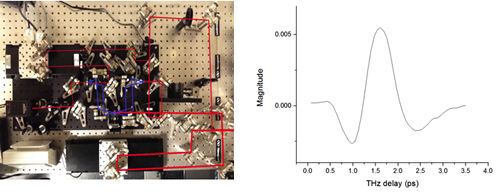
Fig. 1 (A) Layout of Optical Pump THz Probe Spectrometer system. (B) Measured THz signal from probe component of spectrometer.


These graphs shows the humidity dropping in time of the two spectrometer systems, my small a system and the standard sized system in the lab.
Anaylsis: The spectrometer was successfully constructed and used to measure THz. The probe component of the spectrometer took up a small two square feet of space.
The compact size allowed the system to purge nearly twice as quickly as a standard system.
Next Steps: The next step is to align and calibrate the pump beam to make optical pump THz probe measurements
NanoJapan taught me so much about myself. I learned that I want to travel more while I'm still young. I wanted to before, but now I see how important it is in shaping me as a person. Before this trip I wanted to travel, but it wasn't something that I was putting on the forefront of my plans. It was something I wanted but wasn’t doing anything to actually do it. Now I know I definitely want and need to put myself in other cultures and environments. Whether I do this by going back to OIST or applying for other IREU programs it is something I need to do before I got to graduate school and while I still have the time. I think that studying abroad is an experience that every undergraduate should have.
I learned that I can be independent and take care of myself in an unfamiliar place. College has been a cake walk in this sense, and this is the first time where I faced challenges living and communicating on a daily basis. I think that it is important to put myself in uncomfortable situation because I think that is when I learn the most. I learned to communicate, ask for help, and most importantly show respect. I learned that respect isn't necessarily knowing all of the rules right away, but it is most important to show effort that you are trying to be polite. Respect is all about effort, and effort can be given regardless of the communication and cultural boundaries.
I surprised myself while I was there with how outgoing I was in a lot of situations, but I also learned from this that some of the best experiences come form ignoring the voice in your head and not being afraid to make a fool of yourself. This is especially true when it comes to communicating in a foreign language as it is inevitable you re going to mispronounce a word in some bizarre way, but you need the courage to try not only to learn, but also because in the end you will find yourself in fun situations. It is in those awkward moments where you can learn the most.
Through my work at OIST, I learned so many new techniques. For the first half of my research I designed and built an optical pump THz Probe spectrometer. I had some experience with THz, but this expierience allowed me to really learn the details and purposes of the individual components in the spectrometer. Along the way I also learned quite a few “tricks” to simplify alignment or maximize your THz signal.
After I finished the THz spectrometer, I spent the second half of the program characterizing three 2-d layered anti ferromagnetic materials. Ultimately Keshav wants to make ker rotation measurements on them, but first we needed to compare to previous literature to confirm that the samples are what we think they are. To do this, I took Raman, photoluminesence, and UV vis measurements on them. I also set up a system to measure the MOKE of these samples. Keshavs lab is equipped with a 17T magnet that we can use in tandem with a HeNe laser to determine the polarization rotation due to the magnetic ordering of the sample.
In addition to the specific technical research skills I learned, I also feel that I generally have learned how to be more independent and efficient as a researcher. At the beginning of the program, I often felt that I didn't have enough guidance and I would be unsure what steps to take next. I quickly learned that in Keshav's laboratory, everyone is expected to work very independently, even the undergraduate interns. I realized that instead of always asking for help or what step to take next, I instead learned the importance of figuring things out yourself. I realized that to get my project done, I had to push and make sure that each aspect came together. It was solely my responsibility to create the working spectrometer. This taught me the importance of thinking ahead and anticipating problems, doing your own research to solve problems, and also when it is necessary to ask for help.
NanoJapan taught me discipline, independence, and most importantly it taught me to communicate in an international environment. During my time at Okinawa Institute of Science and Technology Graduate University my mentor, Dr. Keshav Dani, gave me a demanding project with a fairly short deadline. At the beginning, I didn't fully appreciate the amount of time that research takes. In my mind each step seemed simple, but I soon found in reality, I ran into a multitude of problems ranging from components not fitting together to faulty equipment. I realized that the only way to ensure the project be finished in time was to put it in the hours. I learned that research doesn’t have set hours like most other jobs. I learned that to finish your work you may need to stay until two in the morning, but this is also what makes research so fun. You are able to get so engrossed with your work and trying to get it to work or solve a problem, that it makes it that much sweeter when you succeed.
At the beginning of the program, I often felt that I didn't have enough guidance and I would be unsure what steps to take next. I quickly learned that in Keshav's laboratory, everyone is expected to work very independently, even the undergraduate interns. I realized that instead of always asking for help or what step to take next, I instead learned the importance of figuring things out yourself. I realized that to get my project done, I had to push and make sure that each aspect came together. It was solely my responsibility to create the working spectrometer. This taught me the importance of thinking ahead and anticipating problems, doing your own research to solve problems, and also when it is necessary to ask for help.
In addition to the work, I also learned the importance and difficulties associated with cross cultural communication. The scientists at OIST come from a wide range of countries and an extremely diverse cultural community results. I learned that there can easily be miscommunication not only due to language barriers, but also just cultural differences. I also learned the importance of clarity and 4respect when working in this kind of environment. I also saw the advantages of this mixing of cultures such as new approaches to problem solving and differing and unique techniques.
I think one of the most important things I received was a more realistic view of what it means to conduct research and what it might be like in graduate school. My work in the lab at Tulane gave me an idea, but I didn't really have a realistic sense of the independence and hard work that was needed in a lab. Research is not a 9-5 job, but it is instead about the research. This often results in many hours, but I also found that they fly by and you find yourself wishing you had more time because you become so engrossed in your work. Initially it seemed daunting, but than I realized that this was the first job I have had where I wasn't counting down hour until I could go home and this was because I found the work truly interesting. The experience definitely cemented my desire to go to graduate school.
I believe that the biggest difference for me after completing NanoJapan, will be that I will likely return to the Dani unit to spend a semester there. I talked with Keshav at the end of the program and we concluded that it would be a great opportunity to come back for a longer period of time: spring and the following summer. This will allow me to really dive into research and hopefully come out with some publishable results. I am currently looking in to going back for my spring semester of my junior year. To do this I will look into getting a visa as well as preparing academically so I can still graduate on time.
In addition to returning to OIST, the NanoJapan Program has given me a thirst for additional international travel/study. I have learned how useful, fun, and eye opening it is to live and experience different cultures and environments. I plan to apply to other REU programs as well as possible fellowships such as full bright. The options that Sarah shared with us at the end were very helpful.
The program has also made me much more sympathetic to those who are living abroad in a foreign country. I never fully appreciated the challenges that come along with not only having to speak a different language but also the small cultural differences that most of us take for granted.
While exploring Japan I was completely astounded by the politeness and safety of the country. People seemed genuine happy to help you if you needed help and I was never met with a frown at a convenient store. Additionally children can walk alone to school and women don't need to worry about walking alone at night. The kip students also mentioned that nearly all students graduate high school and very few teen pregnancies occur. The general order and success of the Japanese people is amazing, but I am still dieing to know why this is?
I think it might be just the cultural difference in that way that they are raised. Maybe it is the group thinking that causes this. Or maybe it is the desire for everyone to be the same. I am unsure but I would like to know why Japan can be so successful in this regard. Because it is so engrained I feel that it likely is a result for the elementary education of children at a young age. However in addition to wanting to know why it is, I would also like to see some more of the downsides to this general homogeneity. I am sure that there are many out there that feel suffocated by this idea that everyone must be the same. This could possibly be seen in the suicide rate. There is some underling ideology that I don’t fully understand that I believe both contributes to the order of the Japanese people while also making some very depressed.